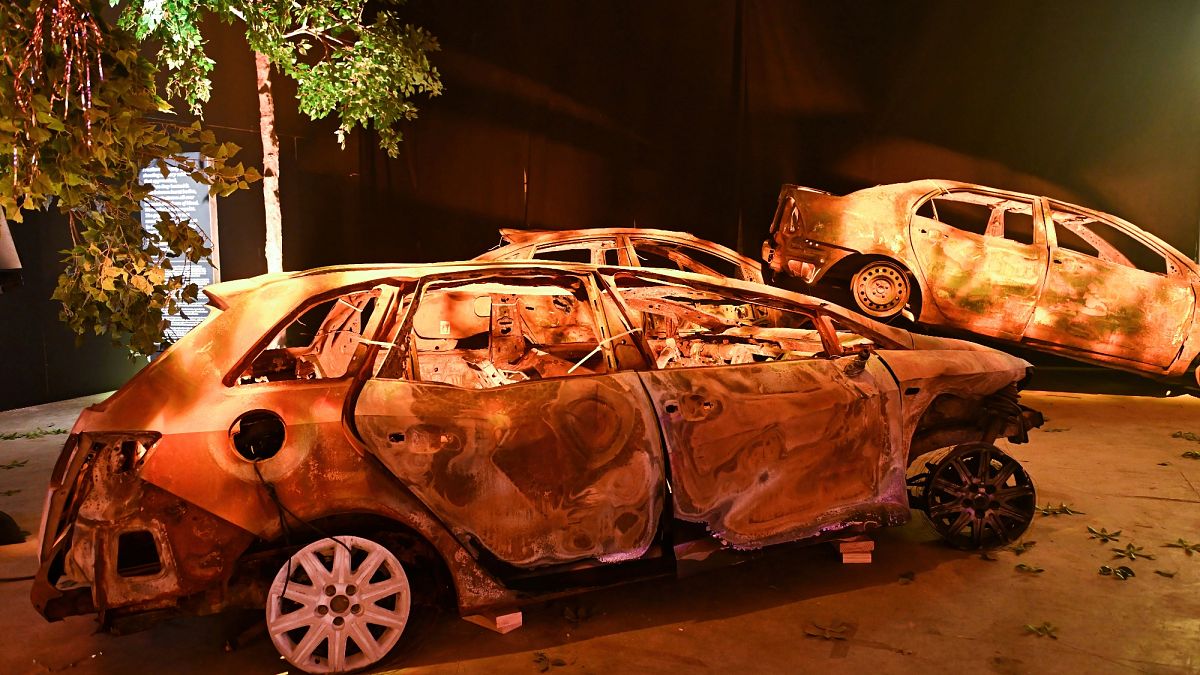A survivor of the 7 October 2023 Hamas attack on the Nova Music Festival in Israel has recalled how he made it out alive, and described his recovery following the massacre.
Thousands of people were partying into the early hours of the morning that day when the music suddenly stopped and only rockets could be heard, according to Roey Dray.
“More and more rockets flew across the sky, more than usual, dozens,” said Dray, who was there with a large group of friends and his brother.
Plumes of grey smoke obscured the sky, but Roey presumed they were safe. After all, rocket attacks were nothing new.
Dray only realised the severity of the attack when the Hamas militants approached. “We had to flee from terrorists who were shooting at us,” he told Euronews in an interview.
Together with his brother, he ran across the festival site. They took their car, got through and picked up a third festivalgoer. “There was no question in my mind. We’re coming home alive, there’s no other way,” said 28-year-old Dray, who comes from Beer Sheva.
Three of his friends didn’t make it. They were killed by Hamas at the festival.
“I had a responsibility to my friends’ families, because I had to tell them how I got here and that their sons, who I was at the festival with, are no longer there,” Dray explained.
Remembering the victims
Ariel Borok from Tel Aviv lost his sister Anita and her boyfriend Segev in Hamas’ attack on the festival. He lost contact with his sister shortly after the violence unfolded.
There was no sign of life for days. Families searched hospitals in the area and Segev’s father even travelled to the festival site.
“At some point we thought that maybe they had been abducted to Gaza. Or that maybe they were dead,” Borok told Euronews. For him, there were only these two possibilities, and he was very worried. About two days later, he recognised his sister in a video.
“In this video, we saw how Anita and Segev had been shot in their car,” said the 41-year-old. “I just didn’t want to believe it at first. “For the first few months, I was just busy with my work. I did everything I could to avoid being confronted with it,” added the engineer.
Anita and Segev were very happy people, according to Borok, who said staying positive for them keeps him going. He has found support from his family and the Nova community.
Euronews met Dray and Borok at the exhibition “October 7, 06:29 AM – The Moment Music Stood Still” at Berlin Tempelhof Airport.
The day before, the last 20 living hostages had been handed over to Israel after a ceasefire in Gaza took effect.
In Tel Aviv, people were dancing, singing and crying. Videos of the reunions spread like wildfire on social media. Eleven of the hostages had attended the Nova music festival.
‘Now we can try to heal ourselves’
Borok said that it was a “very happy day … but also a sad day because some have come back dead”.
However, he stressed that it was a crucial moment for the Israeli community. “Now it’s 8 October”, explained Borok, “now we can try to move on, try to heal ourselves”.
The return of the hostages was also a special moment for Dray.
“We know how Hamas usually behaves, we never thought we would see this day,” he said. Now he has more room to breathe and more space to concentrate on the healing process, added.
Dray said he keeps going back to the festival site — every two months — to see the area and how the space has changed. There is hardly anything left from the festival. It has “become more of a tourist attraction”, he said.
For him, however, the place has remained the same.
“I know where we pitched our tents, I know where the dance floor was, I know where the toilets were, I can still see it in front of me when I’m there,” he recalled.
Dray has told locals about what happened, and he won’t stop talking about his friends. He wants to do that for their relatives and also for himself, to keep the memories alive.
In Berlin, large parts of the festival site including the central stage are on display at Tempelhof Airport, along with remaining artefacts.
Washing lines hang between the trees, half-full drinks stand at the bar, a mobile phone is plugged into the charging cable on the camping chair — as if the festival visitors had just left.
However, upon closer inspection, bullet holes can be seen in the toilet blocks, and the cars in the centre of the room are burnt out. Videos with snapshots, witness reports, and pictures can be heard and seen from all corners of the exhibition.
The exhibition has previously been shown in Tel Aviv, New York, Los Angeles, Miami, Buenos Aires, Toronto and Washington. It will remain in Berlin until 16 November.

